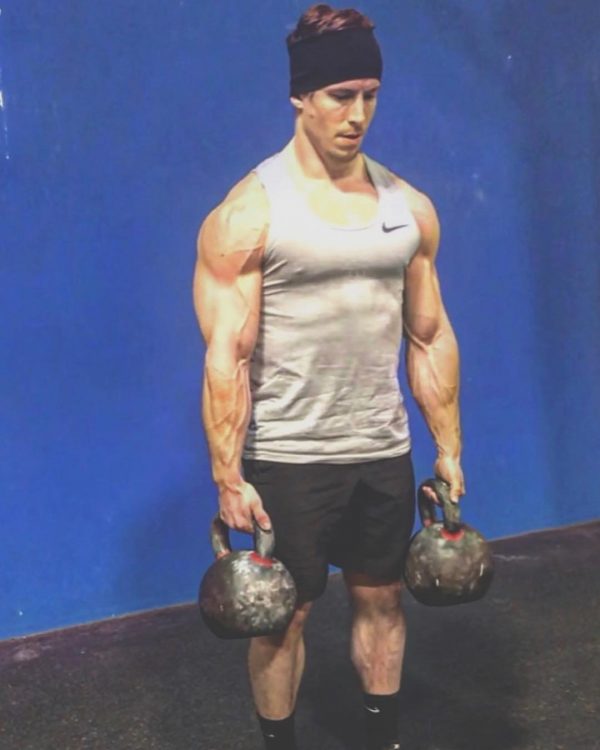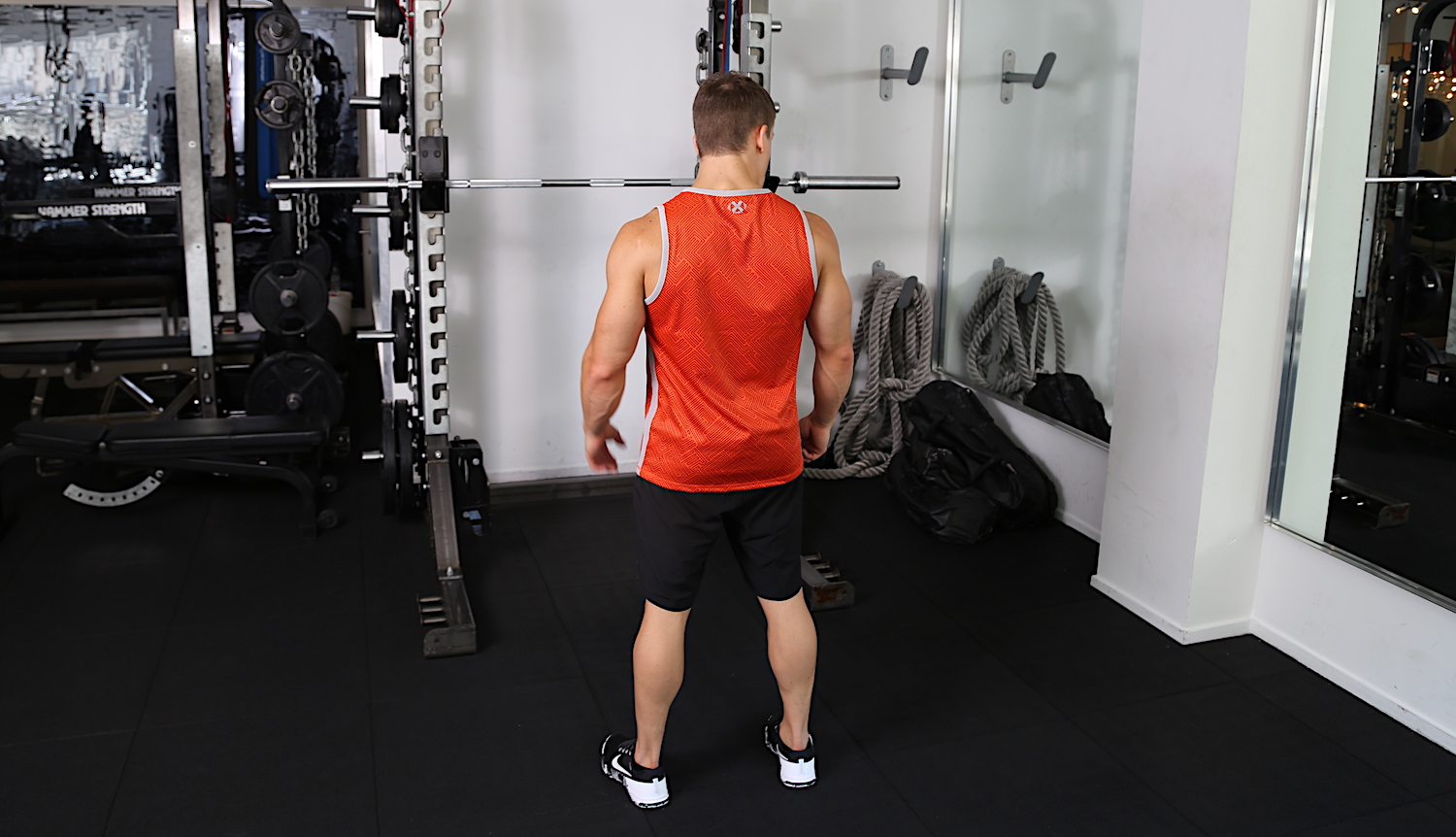The primary objective of the Super-3 workout plan, as designed by HFP expert contributor Wyatt Krueger (@WyattKrueger), is to dramatically increase your strength. It’s a simplified, yet unique and challenging plan with a strategic variety of exercises.
Many of you may have heard of the Big 3. The squat, deadlift, and press. The plan is built around much of that and enhanced with two other elements. The workouts are broken into three parts: a main/compound lift, an accessory lift, and a stabilization lift. These are the Super-3.
A main/compound lift will stimulate several muscles in the body. An accessory lift will act as a supplement to the main/compound lift. By adding in accessory lifts, you can target weaker areas to improve. For example: strengthening weak hamstrings and glutes will improve your squat. The stabilization exercise, which comes last, will improve your midline core strength, ultimately helping all of your other lifts. Overhead stabilization is overlooked in most programs, but should be included various times throughout the week. They’re a game-changer when it comes to shoulder strength, full body strength, shoulder stabilization. They even do a number on your abs and obliques.
How to follow the Super-3 workout plan
For three weeks you’ll workout out three days per week with rest or cardio in between. You might be wondering if three workouts per week and three exercises per session is enough? The answer is, yes. In the Super-3 workout plan you’re effectively covering all muscle groups during those three days, even if you don’t see some of more common exercises from other programs. Additionally, we’re looking to focus heavily on high-quality reps and intense effort versus doing more (exercises and sets) with less intense effort. If you’re giving it your all on every rep and set of each exercise, you’ll be ready for your post-workout shake, nap, and sports massage.
How much weight or resistance to use for lifts
All of your main/compound lifts will have a moderate rep range focusing on strength building instead of size. Volume and specific muscle group targeting will be added in the form of accessory exercises with higher rep ranges. Higher rep overhead stabilization and core lifts will then round out each session.
Rest periods between sets will be 90 seconds to 2 minutes. This will ensure proper recovery before the next set and your best effort to lift more weight.
Each of the three weeks will be the same: all of the muscle groups for improving overall strength and stabilization will be worked. However, the use of different lifts will provide variety, or a different stimulus, to get the same end result: more strength.
Use the first week and first set of each exercise to gauge where you are at with loading for that specific lift. As you progress into week two, try and increase the weight used for each set of all exercises, or stay at the same challenging weight across all sets until you are ready to increase.
What about cardio?
As mentioned above, The Super-3 workout plan is meant to have at least one day of rest or cardio between each workout. Cardio can be anything from HIIT to a longer aerobic bike, row, or run. Cardio can also be put into each workout ideally after all the lifts are completed towards the end of your workout.
For a series of great HIIT (high-intensity interval training) workouts, check out our 5 Hurricane conditioning routines.
The Super-3 overhead exercises for body and core stabilization
1. Bottom Up Overhead KB Carry
The bottoms-up kettlebell press is a great drill to build shoulder strength, stability and mobility. The challenge of keeping the kettlebell upside down teaches you how to tighten the core and find your groove in the press.
This movement is performed unilaterally (on one side) by gripping the kettlebell upside down from the handle and placed directly overhead while bracing the abs and maintaining a tight body position as you slowly walk.
- Trains the Press: It helps you find the right groove for presses. Your shoulder will find the path of least resistance and most stability to press the weight.
- Teaches Core Stability: Your thighs, glutes, abs, and lats must all be kept tight to build a solid foundation for the shoulder to press the kettlebell.
- Relieves Achy Elbows and Shoulders: With the weight upside down, you will feel the pressure in your palm. This tends to keep the elbows in a great position. Bottoms-up presses are also an effective rehab tool, as they build rotator cuff strength.
2. Overhead Walking Lunge
The overhead lunge is a weighted variation of the basic lunge that works the entire body and involves nearly every muscle group. By holding weights overhead, you build upper and lower body strength, increase the power of your legs, and improve core strength.
The overhead lunge not only builds strength in the quadriceps and glute muscles but also improves your balance, core stability. This movement can be done with dumbbells or kettlebells and can also be performed unilaterally with just one arm. A barbell or plate also make great tools to perform the overhead walking lunge.
These are performed with a tight core (think about squeezing your abs and bracing throughout the movement), active shoulders, and arms locked out directly overhead. You will alternate lunge steps, stepping directly into your heal with a vertical shin and driving through that leg into the next step.
3. Behind-the-Neck Snatch Grip Press
Although a bit intimidating, this exercise offers similar benefits as the standard press but can also help to fully develop the upper back, traps, and posterior shoulders, all of which are highly critical in lockout stabilization and packing of the upper back. The behind the head starting point in the lift also allows lifters to potentially overload this pressing movement (when compared to the front racked press), allowing for increased strength development over time.
This lift is performed with a barbell coming from either the rack or ground. In order to perform this lift, you must have some shoulder mobility. Meaning the ability to open up your chest, externally rotate your shoulders and lift the bar straight up from the back rack position. I recommending starting very light to get a feel for the movement and work up in weight from there. If your shoulder mobility is not quite there substitute in one of the other overhead strength and stabilization exercises or take the time to work on your upper body mobility with resistance band stretching.
The 2 exercises to improve your shoulder mobility
1. Resistance Band Front Pull Apart
Resistance Band Front Pull Aparts are one of the best ways to improve scapular mobility and strength in the back and shoulder muscles. Set up with a resistance band in front of you, wrists as straight as possible, shoulder blades and rib cage down. When you draw the resistance band towards your body maintain a neutral posture throughout the exercise, and use your back to perform the exercise allowing your shoulder blades to move freely.
Imagine your shoulders gliding along the side of your body. Do not allow the resistance band tension to forcibly retract to the starting position, maintain your posture, and control the movement back to the beginning. Move your grip in to add more resistance and make this exercise a bit tougher.
Incorporate the resistance band front pull apart in your warm up for all of your workouts to improve your mobility and strength. You will be performing the Snatch Grip Behind The Neck Press in no time.
2. Resistance Band Pass Throughs
A must in any workout that requires you to open up your shoulder and lift over head. The increased mobility by performing the resistance band pass throughs will allow you to lift properly, work through great range of motion, and maximize your performance on any lifts dealing with your shoulders. Start with the resistance band in front down by your hips and slowly front raise the band up keeping your shoulder and rib cage down and arms fully extended. Start with a few to just behind your ears and as mobility increases, work your way back for a full pass through.
You may also substitute in a pvc pipe or any other straight object that allows you to maintain a similar grip. Perform these in every warm up or cool down to increase shoulder mobility.
The Super-3 accessory exercises for supplementing the main/compound lift
1. Tall Kneeling Single Arm Kettlebell Press
An effective unilateral exercise to increase shoulder strength along with core and midline strength. Start in the kneeling position bringing the kettlebell into the front rack position. While squeezing your abs and preventing any over extension of the back, press the kettlebell directly overhead to a full locked out position.
2. Glute Ham Raise
Done on the Glute Ham Developer machine, these are a must in developing the hamstrings and glutes. Similar to a hamstring curl machine, these are done using your bodyweight (or add weight in the form of med-ball or plate). With the torso perpendicular to the floor and the knees in a straight line with your neck. Maintain that body alignment by squeezing your glutes, hamstrings, and abs, and slowly lower yourself until you’re parallel to the floor. Come back up in the same manner maintaining the same alignment.
Note: if your gym does not have a Glute Ham Developer machine you can substitute the hamstring curl machine to effectively target the same muscle groups.
3. Double Kettlebell Deadlift
Consider this a full-body strength-developer. Two heavier kettlebells placed on the outside of your hips, slowly push your hips back while keeping your chest up, shoulder back, and maintain that natural lumbar curve. Track the kettlebells down along your legs, tap the floor maintain tension in the glutes and hamstrings. No kettlebells? No problem. Dumbbells can be substituted for a similar stimulus.
The 3-week Super-3 workout plan routines

Week 1/Day 1: Shoulders/Upper Body Accessory/Overhead Stabilization
1:30-2:00 rest between sets: increase weight with each set
1.Strict Press 4 x 6
2.Tall Kneeling Single Arm Kettlebell Press 4 x 10
3.Bottom Up Overhead Kettlebell Carry 4 x 60’
Week 1/Day 2: Legs/Lower Body Accessory/Lower Body+Core+Overhead Stabilization
1:30-2:00 rest between sets: increase weight with each set
1.Front Squat 4 x 6
2.Glute Ham Raise 4 x 12-15
3.Overhead Walking Lunges 4 x 20 (10 each side)
Week 1/Day 3: Posterior Legs/Back+Lower Body Accessory/Core+Overhead Stabilization
1:30-2:00 rest between sets: increase weight with each set
1.Deadlift 4 x 6
2.Barbell Good-mornings 4 x 10
3.Static Overhead Plate Hold 4 x 1:00
Week 2/Day 1: Shoulders/Upper Body Chest Accessory/ Core+Overhead Stabilization
1:30-2:00 rest between sets: increase weight with each set
1.Strict Press 5 x 5
2.Banded Push Up 4 x To Failure
3.Double Overhead Dumbbell Walk 4 x 60 ft.
Week 2/Day 2: Legs/Anterior Legs Accessory+Core/ Shoulder+Core Stability
1:30-2:00 rest between sets: increase weight with each set
1.Back Squat 4 x 6
2.Kettlebell Goblet Squat 4 x 15
3.Shoulder Taps 4 x 20
Week 2/Day 3: Posterior Legs/Back/Upper Back+Shoulder+Overhead Stabilization
1:30-2:00 rest between sets: increase weight with each set
1.Double Kettlebell Deadlift 4 x 15-20
2.Bent-Over Barbell Row 4 x 10
3.Behind-the-Neck Snatch Grip Press 4 x 10
Week 3/Day 1: Shoulders/Upper Body Accessory/Overhead Stabilization
1:30-2:00 rest between sets: increase weight with each set
1.Strict Press 6 x 3
2.Tall Kneeling Kettlebell Front Rack Press 4 x 10
3.Bottom Up Overhead Kettlebell Carry 4 x 60’
Week 3/Day 2: Anterior Legs/Lower Body Accessory/Lower Body+Core+Overhead Stabilization
1:30-2:00 rest between sets: increase weight with each set
1.Front Squat 5 x 5
2.Glute Ham Raise 4 x 12-15
3.Overhead Walking Lunges 4 x 20 (10 each side)
Week 3/Day 3: Posterior Legs/Back+Lower Body Accessory/Core+Overhead Stabilization
1:30-2:00 rest between sets: increase weight with each set
1.Deadlift 5 x 5
2.Barbell Good-mornings 4 x 10
3.Static Overhead Plate Hold 4 x 1:00

